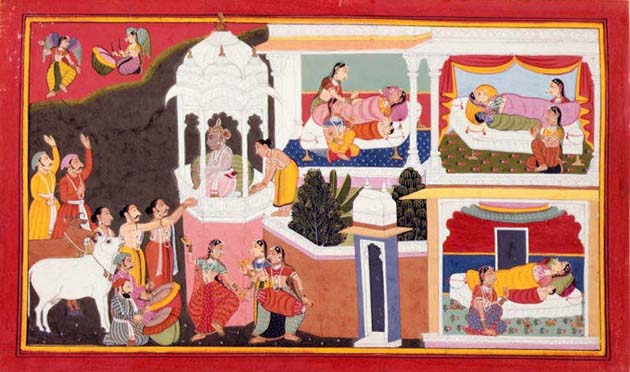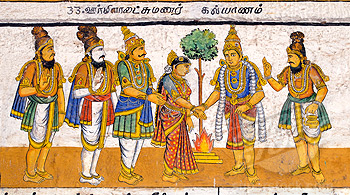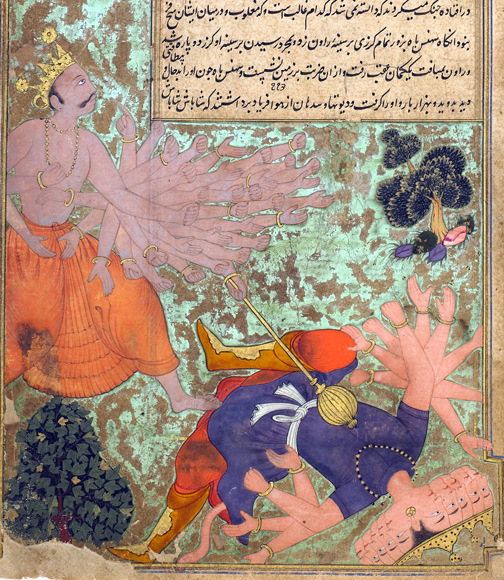|
Sumitra
Sumitra (, IAST: Sumitrā) is a princess of Kashi and the queen of Kosala in the Hindu epic ''Ramayana''. Sumitra is the second queen consort of Dasharatha, the king of Kosala, who ruled from Ayodhya. Regarded to be a wise and dedicated woman, she is the mother of the twins Lakshmana and Shatrughna. Etymology The name Sumitra is of Sanskrit origin, and could be divided into ''Su'' meaning good, and ''Mitra,'' meaning friend''.'' Thus'','' her name means 'a good friend' or 'one with a friendly nature'. She is known in other languages as Tamil: சுமித்திரை (), Burmese: Thumitra, Malay: Samutra, Khmer '' and '' ''Samutthra Thewi''). Legend Birth While Valmiki is silent on her parentage, later texts variously described her as a princess of Kashi or of Magadha, and belonging to the Haiheya clan. She is called the daughter of Magadha, as per Kalidasa’s '' Raghuvamsham''. Kalidasa wrote, Marriage and children Sumitra was married to king Da ... [...More Info...] [...Related Items...] OR: [Wikipedia] [Google] [Baidu] |
Dasharatha
Dasharatha (, IAST: Daśaratha; born Nemi) was the king of Kosala, with its capital at Ayodhya, in the Hindu epic ''Ramayana''. Dasharatha married Kausalya, Sumitra and Kaikeyi. He was the father of Rama, the protagonist of the epic Ramayana, Bharata, Lakshmana, and Shatrughna. Dasharatha also finds mention in the ''Vishnu Purana''. Legend Early life and marriage King Dasharatha was believed to be an incarnation of Svayambhuva Manu, the son of the Hindu creator god, Brahma. Dasharatha was born as the son of King Aja of Kosala and Indumati of Vidarbha. He was originally named Nemi, but he acquired the moniker ''Dasharatha'' ('ten chariots') as his chariot could move in all ten directions, fly, and return to earth, and he could fight with ease in all of these directions. Dasharatha became the ruler of Kosala after the death of his father. He was a great warrior who subjugated many of the neighbouring kingdoms with his prowess and slew many asuras in battle. According ... [...More Info...] [...Related Items...] OR: [Wikipedia] [Google] [Baidu] |
Lakshmana
Lakshmana (, ), also known as Laxmana, Lakhan, Saumitra, and Ramanuja, is the younger brother of Rama in the Hindu epic ''Ramayana''. He is considered as an incarnation of Shesha, the lord of serpents. Lakshmana was married to Urmila, and is known for his loyalty and dedication towards Rama. Lakshmana was born to King Dasharatha of Ayodhya and Queen Sumitra. Shatrughna, is his twin brother. He was married to Urmila, after his brother Rama married Sita in her swayamvara. Lakshmana devoted himself to Rama since childhood and accompanied him during his fourteen-year exile, serving him and Sita endlessly. He also played a pivotal role in the war and killed Meghanada. Lakshmana is worshipped in Hinduism, at various places in India, alongside Rama and Sita. Etymology The name Lakshmana is of Sanskrit origin, which means 'the one endowed with auspicious signs'. He bears the epithets of Saumitra (, ) and Ramanuja (, ). Legend Birth and early life King Dasharatha of A ... [...More Info...] [...Related Items...] OR: [Wikipedia] [Google] [Baidu] |
Solar Dynasty
The Solar dynasty or (; ), also called the Ikshvaku dynasty, is a legendary Indian dynasty said to have been founded by Ikshvaku. In Hindu texts, Hindu literature, it ruled the Kosala Kingdom, with its capital at Ayodhya (Ramayana), Ayodhya, and later at Shravasti. They worshipped their Kuladevata, clan deity, Surya (a Hindu solar deity), after whom the dynasty is named. Along with the Lunar dynasty, the Solar dynasty comprises one of the main lineages of the Kshatriya Varna (Hinduism), varna in Hinduism. According to Jain literature, the first ''Tirthankara'' of Jainism, Rishabhanatha himself, was King Ikshvaku. Twenty-one further ''Tirthankaras'' were born in this dynasty. According to Buddhist literature, Gautama Buddha descended from the this dynasty. The important personalities belonging to this royal house are Mandhatri, Muchukunda, Ambarisha, Bharata (Jainism), Bharata, Bahubali, Harishchandra, Dilīpa, Sagara (Vedic king), Sagara, [...More Info...] [...Related Items...] OR: [Wikipedia] [Google] [Baidu] |
Kaikeyi
Kaikeyi,(Sanskrit: कैकेयी, IAST: Kaikeyī) is a princess of Kekeya and the queen of Kosala in the Hindu epic ''Ramayana''. Kaikeyi is the third queen and favourite consort of King Dasharatha, who ruled Kosala from its capital, Ayodhya. She is the mother of Bharata. Out of Dasharatha's three wives, Kaikeyi exerts the most influence. Formerly the princess of Kekeya, she is described to have served as an able counsellor to her husband during times of war. Initially loving and motherly towards her stepson, Prince Rama, Kaikeyi's mind is poisoned by Manthara, her maid. Under her influence, Rama is exiled to the forest for a period of fourteen years. Legend Birth and early life Kaikeyi is born to King Ashvapati of Kekeya shortly before her mother was exiled. She was raised with her only mother figure being her hunchbacked nursemaid, Manthara. She is raised with seven brothers, including her twin, Yudhājit. Marriage and child Kaikeyi is married to the ki ... [...More Info...] [...Related Items...] OR: [Wikipedia] [Google] [Baidu] |
Kausalya
Kausalya (, ) is a queen of Kosala in the Hindu epic ''Ramayana''. She is the first senior queen consort of Dasharatha, who ruled Kosala from its capital Ayodhya. She is the mother of Rama, the male protagonist of the epic. She is a secondary character in the ''Ramayana'', so only aspects of her life are described in detail. Legend Birth Valmiki, the author of the ''Ramayana'', does not mention the names of Kausalya's parents, but in the chapter titled, '' Ayodhyakanda'' she is described as ''Kosalendraduhitā'' (i.e., daughter of the king of Kosala). Kosala was a region of ancient India, which had Ayodhya as its capital. The Padma Purana also explains that Kausalya was the daughter of a Kosalan prince. Later texts name her as the daughter of the King Sukaushala and Queen Amritaprabha of Dakshina Kosala. At her traditionally ascribed birthplace, there exists a temple dedicated to her called the Mata Kaushalya Temple, which is perhaps among the few temples dedicated to her. ... [...More Info...] [...Related Items...] OR: [Wikipedia] [Google] [Baidu] |
Shatrughna
''Shatrughna'' (, ), also known as Ripudaman, is the younger brother of Rama, and King of Mathura, Madhupura and Vidisha, in the Hindu epic ''Ramayana''. He is considered as an incarnation of the Sudarshana Chakra of god Vishnu, and was married to Shrutakirti. Shatrughna is the twin of Lakshmana. He is a loyalist of Bharata (Ramayana), Bharata, just like Lakshmana is to Rama. Shatrughna appears as the 412th name of Vishnu in the ''Vishnu Sahasranama'' of the ''Mahabharata''. Etymology The name Shatrughna is of Sanskrit origin. ''Shatru'' means 'enemy' and ''Ghna'' means 'kill'. His name means 'killer of enemies'. Legend Birth and early life King Dasharatha of Ayodhya (Ramayana), Ayodhya had three wives: Kausalya, Kaikeyi, and Sumitra. Shatrughan and his elder brother Lakshmana were born to Sumitra, while Rama and Bharata (Ramayana), Bharata were born to Kausalya and Kaikeyi. In the ''Ramayana'', he is described as an incarnation of Sudarshana Chakra. Marriage to Shrutakir ... [...More Info...] [...Related Items...] OR: [Wikipedia] [Google] [Baidu] |
Bharata (Ramayana)
Bharata ( ) is the younger brother of Rama in Hindu epic ''Ramayana'', and the regent of Ayodhya during Rama's exile. Bharata is considered as an incarnation of the Panchajanya of god Vishnu, and was married to Mandavi. Bharata is regarded for his devotion towards his elder brother Rama. He went against his mother and refused the throne of Ayodhya while elder brother, Rama, was exiled. Bharata also lived a life in exile, in Nandigram, Ayodhya, till Rama, Sita and Lakshmana returned to Ayodhya. He is mostly worshipped in Kerala. Etymology The name Bharata is of Sanskrit origin. His name means "one to be r beingmaintained". Legend Birth and early life King Dasharatha of Ayodhya had three wives: Kausalya, Kaikeyi, and Sumitra. Bharata was born to Kaikeyi, while Rama was born to Kausalya, and Lakshmana and Shatrughna were born to Sumitra. In the ''Ramayana'', he is described as an incarnation of Panchajanya. While Lakshmana was a loyalist of Rama, his twin, Shatrughn ... [...More Info...] [...Related Items...] OR: [Wikipedia] [Google] [Baidu] |
Ramayana
The ''Ramayana'' (; ), also known as ''Valmiki Ramayana'', as traditionally attributed to Valmiki, is a smriti text (also described as a Sanskrit literature, Sanskrit Indian epic poetry, epic) from ancient India, one of the two important epics of Hinduism known as the ''Itihasas'', the other being the ''Mahabharata''. The epic narrates the life of Rama, the seventh ''avatar'' of the Hindu deity Vishnu, who is a prince of Ayodhya (Ramayana), Ayodhya in the kingdom of Kosala. The epic follows Exile of Lord Rama, his fourteen-year exile to the forest urged by his father King Dasharatha, on the request of Rama's stepmother Kaikeyi; his travels across the forests in the Indian subcontinent with his wife Sita and brother Lakshmana; the kidnapping of Sita by Ravana, the king of Lanka, that resulted in bloodbath; and Rama's eventual return to Ayodhya (Ramayana), Ayodhya along with Sita to be crowned as a king amidst jubilation and celebration. Scholarly estimates for the earliest stage ... [...More Info...] [...Related Items...] OR: [Wikipedia] [Google] [Baidu] |
Heheya Kingdom
In the Mahabharata epic, the Haihaya kingdom (also spelled Heheya, Haihaya, Haiheya, Heiheya, etc.) is one of the kingdoms ruled by Chandravanshi (Yadava) kings in central and western India. It was ruled by Kartavirya Arjuna, who defeated Ravana. Its capital was Mahishmati on the banks of river Narmada River, Narmada in present-day Madhya Pradesh. Talajangha was an allied kingdom to the east of Heheya. They conquered many other kingdoms of India until enmity with the warrior ''Bhargavas'' resulted in their demise. Parasurama was the Bhargava leader who ended the kingdom. Haihaya clans The Haihayas () were an ancient confederacy of five ''gana''s (clans), who claimed their common ancestry from Yadu. According to the Harivamsa, Harivamsha Purana (34.1898) Haihaya was the great-grandson of Yadu and grandson of Sahasrajit.Pargiter, F.E. (1972) [1922]. ''Ancient Indian Historical Tradition'', Delhi: Motilal Banarsidass, p.87. In the Vishnu Purana (IV.11), all the five Haihaya clans ... [...More Info...] [...Related Items...] OR: [Wikipedia] [Google] [Baidu] |
Kosala
Kosala, sometimes referred to as Uttara Kosala () was one of the Mahajanapadas of ancient India. It emerged as a small state during the Late Vedic period and became (along with Magadha) one of the earliest states to transition from a lineage-based society to a monarchy. By the 6th century BCE, it had consolidated into one of the four great powers of ancient northern India, along with Magadha, Vatsa, and Avanti. Kosala belonged to the Northern Black Polished Ware culture (c. 700–300 BCE) and was culturally distinct from the Painted Grey Ware culture of the neighboring Kuru- Panchala region, following independent development toward urbanisation and the use of iron. The presence of the lineage of Ikshvaku—described as a raja in the Ṛgveda and an ancient hero in the Atharvaveda—to which Rama, Mahavira, and the Buddha are all thought to have belonged—characterized the Kosalan realm. One of India's two great epics, Ramayana is set in the "Kosala- Videha" realm i ... [...More Info...] [...Related Items...] OR: [Wikipedia] [Google] [Baidu] |
Rama
Rama (; , , ) is a major deity in Hinduism. He is worshipped as the seventh and one of the most popular avatars of Vishnu. In Rama-centric Hindu traditions, he is considered the Supreme Being. Also considered as the ideal man (''maryāda'' ''puruṣottama''), Rama is the male protagonist of the Hindu epic '' Ramayana''. His birth is celebrated every year on Rama Navami, which falls on the ninth day of the bright half ( Shukla Paksha) of the lunar cycle of Chaitra (March–April), the first month in the Hindu calendar. According to the ''Ramayana'', Rama was born to Dasaratha and his first wife Kausalya in Ayodhya, the capital of the Kingdom of Kosala. His siblings included Lakshmana, Bharata, and Shatrughna. He married Sita. Born in a royal family, Rama's life is described in the Hindu texts as one challenged by unexpected changes, such as an exile into impoverished and difficult circumstances, and challenges of ethical questions and moral dilemmas. The most not ... [...More Info...] [...Related Items...] OR: [Wikipedia] [Google] [Baidu] |
Balakanda
''Bala Kanda'' (; IAST: ', ) is the first Book of the Valmiki ''Ramayana.'' The ''Bala Kanda,'' in partif not in its entiretyis generally regarded as an interpolation to the original epic.'''' Structure The book consists of seventy-six ''sargas'' (sometimes translated as ''chapters'' or "cantos") of Sanskrit verse. Synopsis The Bāla Kāṇḍa begins with the sage Vālmīki asking Nārada if there is a righteous man still left in the world, to which Nārada replies that such a man is Rāma. After seeing two birds being shot, Vālmīki creates a new form of meter called ''śloka'', and then is granted the ability to compose an epic poem about Rāma. He teaches his poem to the boys Lava and Kuśa, who recite it throughout the land and eventually at the court of king Rāma, which then begins the main narrative. The king of Kosala, Daśaratha, lives in Ayodhyā, a utopian city, however he has no son. He and his court resolve to bring the sage R̥śyaśr̥ṅga in order to grant ... [...More Info...] [...Related Items...] OR: [Wikipedia] [Google] [Baidu] |









